When a celebrity is involved in a car accident or personal injury claim, headlines often focus on who’s to blame. But the legal answer isn’t always that simple. In many cases, more than one party shares responsibility, which is where comparative fault comes in.
This legal doctrine plays a big role in how lawsuits unfold—and how much money is awarded—especially in high-profile cases involving the rich and famous.
Understanding Comparative Fault
Comparative fault (also called comparative negligence) is a rule courts use to divide blame among multiple parties in an accident. It recognizes that both the plaintiff and the defendant can bear some level of fault—and adjusts financial compensation accordingly.
There are generally two main types of comparative fault systems in the U.S.:
-
Pure Comparative Fault:
A person can recover damages even if they are 99% at fault, but their compensation is reduced by their percentage of responsibility. -
Modified Comparative Fault:
The injured party can only recover damages if they are less than 50% or 51% at fault, depending on the state.
In either system, the idea is that fault isn’t always black-and-white—and legal outcomes should reflect that.
How Comparative Fault Plays Out in Celebrity Cases
Example 1: Two-Vehicle Collision
Imagine a crash between a famous actor and a rideshare driver. The celebrity ran a red light, but the rideshare driver was speeding. If the actor is found 70% at fault and the driver 30%, the driver may still recover damages—but 30% would be deducted from the total award.
Now reverse the scenario: If the celebrity sues, claiming the other party caused the crash, but the celebrity was partially distracted or impaired, that percentage of fault could drastically reduce their potential recovery or even bar them from collecting anything (in a modified fault state).
Why Comparative Fault Matters in High-Profile Lawsuits
-
Media Pressure Can Skew Perceptions
Public sympathy or outrage doesn’t determine legal fault. Even when a celebrity is portrayed as the clear villain or victim, comparative fault gives courts a more nuanced framework. -
Settlements Are Influenced by Fault Percentages
Lawyers often negotiate based on how blame might be assigned. If the star is partially at fault, they may push for a lower settlement—or agree to pay less. -
Insurance Companies Use It to Limit Payouts
In celebrity-involved cases, insurers might highlight the celebrity’s fault—even if minor—to reduce financial exposure.
Recent Examples from the Headlines
-
In several well-publicized crashes, plaintiffs claimed a celebrity driver was 100% responsible. But after investigation, both parties were found partially at fault, leading to reduced settlements or shared liability agreements.
-
Some celebrities have sued others after being injured in collisions—only to lose a portion of the damages because evidence showed they contributed to the unsafe conditions.
Takeaway: Fault Is Rarely One-Sided
In personal injury law, and especially in celebrity accident lawsuits, comparative fault adds layers of complexity. It ensures the courts don’t treat fame as guilt or innocence, but instead rely on proportionate responsibility.
Whether you’re following a celebrity’s legal battle or involved in your own accident claim, understanding comparative fault helps you make sense of outcomes that might seem unfair on the surface—but are carefully calculated behind the scenes.

